The Toyota 4Runner name doesn't quite have the cachet of a Range Rover or Jeep Wrangler, but since 1982 the built-in-Japan SUV has been bounding around America's trails, woods and rock piles.
The previous-generation 4Runner SUV was old. That fifth-generation model ran for almost 15 years, about twice as long as the lifespan of traditional SUV, making it by far the oldest vehicle in Toyota's lineup. With its long-anticipated revision, the Jeep Wrangler and Ford Bronco fighter is all new.
The 2025 Toyota 4Runner, on sale now, has a host of new mechanical and technological options galore including two new engines, three drivetrain variations and six different suspension setups, making it a de facto "easy button" for choosing your own off-road adventure.
Toyota rented space at the Vogt Ranch in the dry, dusty hills near San Diego and let us loose on all nine trims of the 2025 4Runner on slow and fast trails, over boulders and on curvy mountain roads to get a sense of the new vehicle.
Returning trims include the base SR5, TRD Sport, TRD Off-Road and Limited. The 4Runner Trailhunter and Platinum are new. There are two four-wheel drive systems on offer, part-time and full-time, and a two-wheel drive setup on the SR5 with a standard rear limited-slip differential.


Like the new Land Cruiser and Tacoma, the 4Runner rides on the company's TNGA-F platform and offers the same new i-Force engines. The 2.4-liter turbocharged i-Force delivers 278 horsepower (hp) and 317 pound-feet (lb-ft) of torque. The i-Force Max adds a hybrid component, and loses some cargo space, making 326 hp and 465 lb.-ft. of torque. Both have an eight-speed automatic transmission.
The 4Runner can towing 6,000 pounds in this generation, up from 5,000 in the previous.
The 2025 Toyota 4Runner doesn't look much different from its predecessor. It has an angular nose and wide fender flares (even wider on the Trailhunter trim). It also sticks with the fog lights and open grille, however the new Platinum trim gets chrome accents on the front end for a luxe look, and an adaptive suspension.
Most versions of the new 4Runner feel trucky. That's not a bad thing if a buyer is looking for something rugged. We tested almost every trim of the legendary SUV and found that all of them, besides the Limited and Platinum, run more like a pickup truck over average roads. The SR5 and TRDs bounce around on and off-road, however, with the off-road wheels and massive, knobby tires the 4Runner is protected against potholes on the road and razor-sharp rocks off it.
The big body (the 4Runner is longer than the Bronco and far longer than the Jeep Wrangler; the Ford Bronco is wider) sways over undulating roads and curves and the bounces and rebounds last longer than a modern unibody crossover or SUV. It never felt uncomfortable, even after a few hours on the road, it just feels like a pickup.
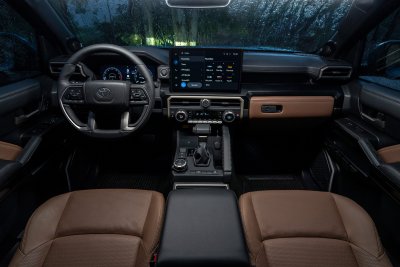
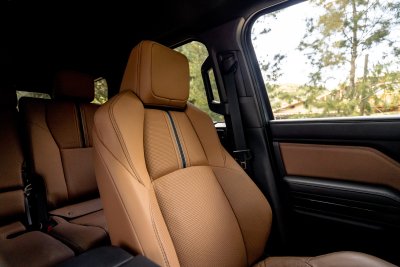
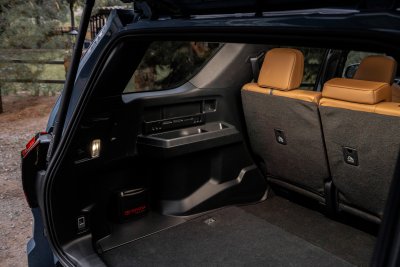
Doing true off-roading allows the SUV's tech to shine. The Multi-Terrain Monitor popped up on the 14-inch touchscreen infotainment display in the tester and once engaged, comes on whenever the vehicle is going less than 10 miles per hour.
There are several different views but the most useful now shows vehicle edge lines, so I could more easily plan which rocks not to hit, but also tire lines that move when the wheel is turned. Coming over a 50-degree incline, there was nothing to see but sky unless I hung my body out of the window and checked on the left front tire, hoping I was clear on the right. With the cameras I just crept into the clouds, looking at the road on the other side of the hill, knowing I needed to jog right so as not to roll off into the scrubby brush on the sides of the trails. It was almost too easy.
4Runner Trailhunter specializes in slow-speed rock crawling while the 4Runner TRD grades are made for high-speed desert runs. On the higher-speed roads, the 4Runner rotated easily on the dirt when giving it gas and dug in when slamming on the brakes. Toyota helpfully put red cones on the fast trails when it was time to slow down for an obstacle, so I was able to push the 4Runner a bit harder than the average person would.
On- and off-road, the two new engines aren't shy about sending sound into the cabin, especially when hanging in gear gripping over boulders, but also when passing slower traffic. With the turbo whistling even when the engine isn't strained, the medium-sized four-cylinder almost sounds like a diesel engine. Like diesel, torque from the less powerful engine still feels completely adequate, even in a vehicle of this size. The upgraded i-Force Max engine makes the SUV feel more like a Ford Raptor competitor than the brother of the bulky Sequoia.
Base 2025 4Runner's come with an 8-inch touchscreen infotainment system that looks out of place with a large plastic bezel, but most come with a 14-inch display with wireless Apple CarPlay, Android Auto, wireless charging and USB-c ports. A 12.3-inch digital and customizable gauge cluster is standard on trims with the i-Force Max engine.
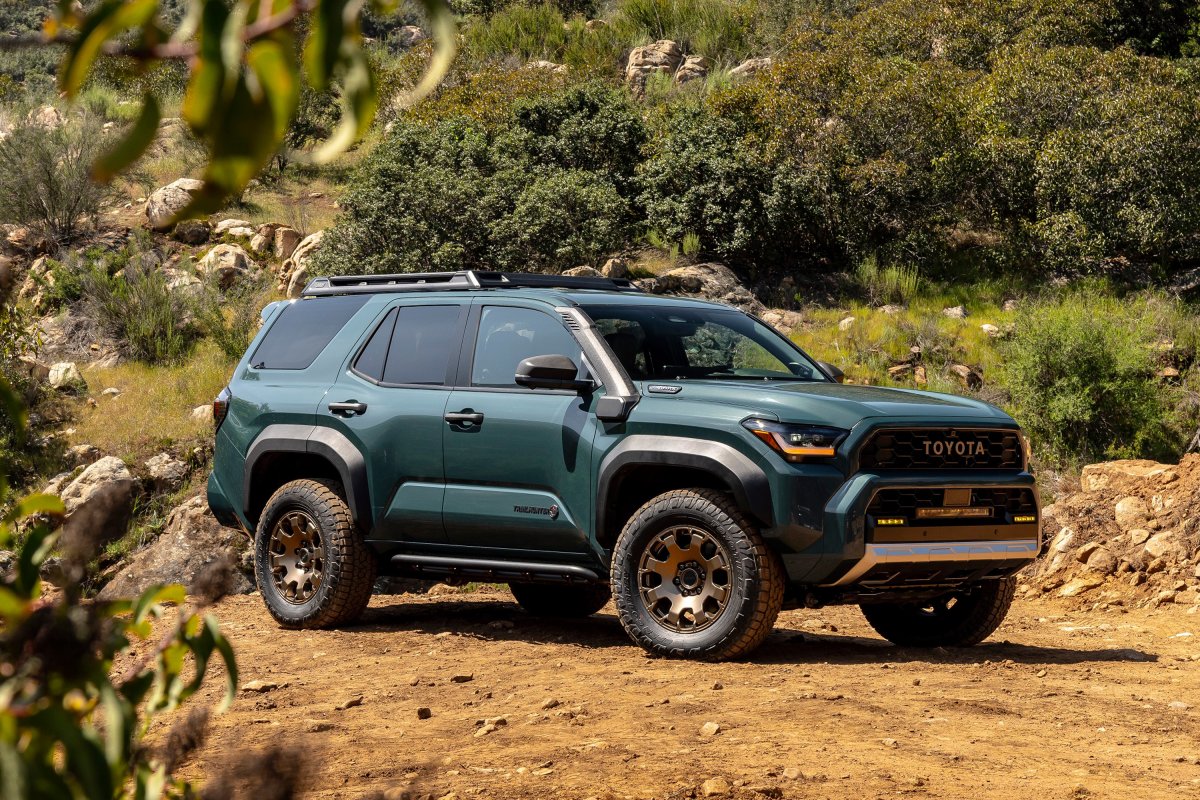
The third row takes some body folding to get into, and the seat bottoms need to be moved into place. As an average-sized adult male, my head was uncomfortably hitting the ceiling while seated there. There are also no child car seat connection points back there.
Notably, the third row is only available on vehicles without the hybrid Max powertrain, as the battery takes up a couple cubic feet of space where those two passengers would sit.
Keyless entry and push button start are standard and a digital smartphone key is available. The excellent and recommended 14–speaker JBL sounds system is optional and like the Toyota Tacoma, the 4Runner features a JBL Flex portable speaker that is removable from the dash and works through Bluetooth. Toyota says it can run for up to six hours and be submerged in up to 3 feet of water before it fails.
The standard cloth and available Softex seats are heated and cooled, comfortable and supportive off road. They also adjust high enough to get a good view of the surrounding terrain, including what you can't see on the cameras. The 4Runner doesn't offer the trick IsoDynamic Performance Seat like the Tacoma, saying the midsize pickup is a "me" vehicle while the 4Runner is a "we" vehicle.
The controls on all trims are plastic, but chunky and clicky and easy to feel without looking. The center console dial adjusts the drive and terrain modes, the downhill and crawl control and other four-wheel drive settings. It's all intuitive after a few uses and I will say that Sport driving mode, on or off-road, definitely turns up the acceleration (and cabin noise).
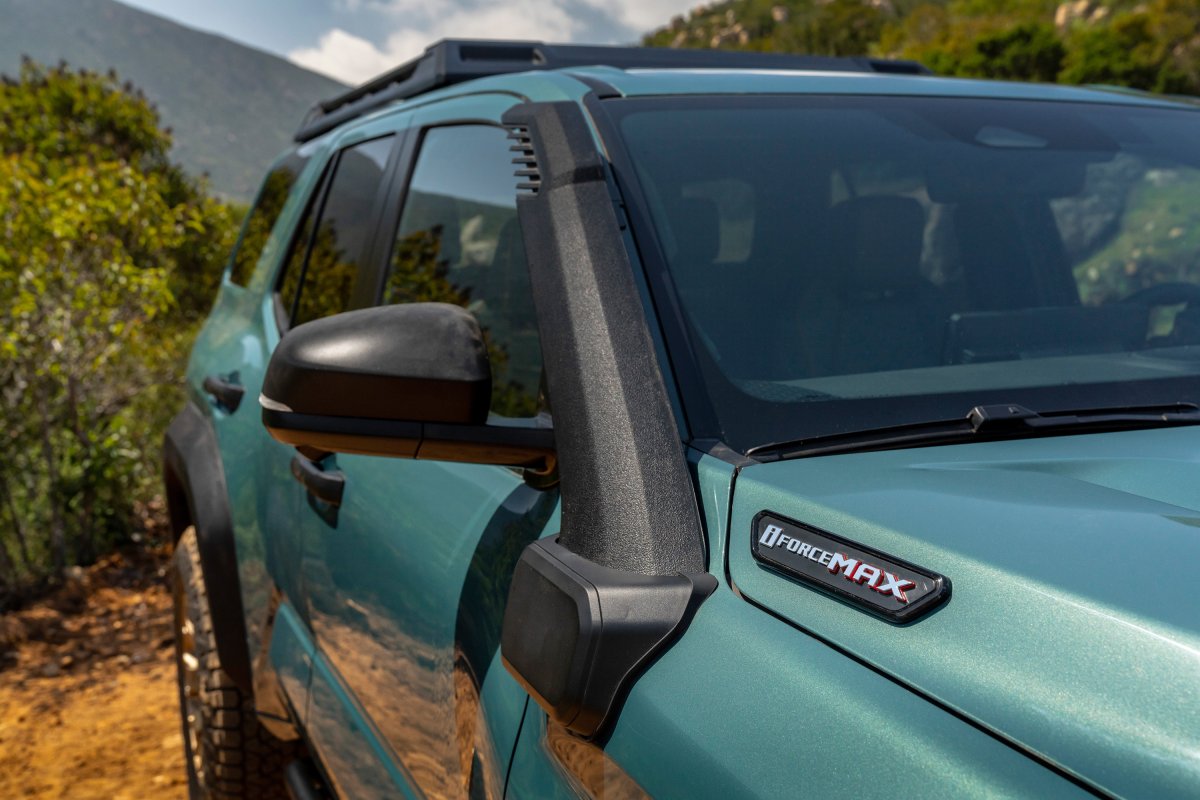
All 2025 4Runner models feature Toyota Safety Sense 3.0 with forward collision warning, lane departure alert and keeping, full-speed adaptive cruise control, lane tracing, road sign assist and auto high beams.
The new Proactive Driving Assist feature will gently brake or steer as necessary to follow the lane or keep a safe distance from the vehicle in front while on roadways where markings are clear (not off-road). Compared to other Toyota driver assist technology it is very unobtrusive. It doesn't beep or vibrate or flash, it just gently nudges the vehicle near the center of the lane. If you happen to be looking away, the wheel's movement reminds you to stay on task. It works independent of cruise control and can be adjusted within the settings.
An Emergency Driving Stop System is also now part of lane tracing operations. This feature monitors the driver's inputs to see they're inattentive or non-responsive and can bring the vehicle to a stop if the driver doesn't respond to alerts to take control.
Like the Jeep Wrangler and Ford Bronco, the 2025 Toyota 4Runner has more capability built in than 90 percent of the drivers on the roads. Between the cameras and the slow-speed, up-and-down Crawl Control feature that works like cruise control off road, anyone can go deep into the wilderness.
4Runner looks cooler than Wrangler and Bronco. For the 2025 model year, Toyota's most off-road worthy SUV starts at $40,700 for the SR5 trim. Four-wheel drive adds $2,000. The 4Runner TRD Off-Road is $49,190; the i-Force Max engine adds $2,000 to that price when specified. The new Platinum trim starts at just under $63,000 and the 4Runner maxes out at the Trailhunter trim for $66,900.
The two-door Ford Bronco starts at $39,603; adding two more doors costs $740. Besides the Raptor version, the Bronco tops out at about $70,000. The Jeep Wrangler starts at $36,595 and goes up to more than $90,000 with the V8-equipped Rubicon 392.
All three can go nearly anywhere. If you need space and style, the 4Runner is the best choice. For the narrowest and toughest trails, get a two-door Wrangler. The Ford falls somewhere between. All are close in price meaning it will come down to personal preference more than anything. On the street, the Bronco might be the most civil. However, the most fun to be had in any of these SUVs is nowhere near a paved road.
About the writer
Jake Lingeman is a Newsweek Autos managing editor based in Detroit. His focus is reporting on the auto industry. He has covered ... Read more



